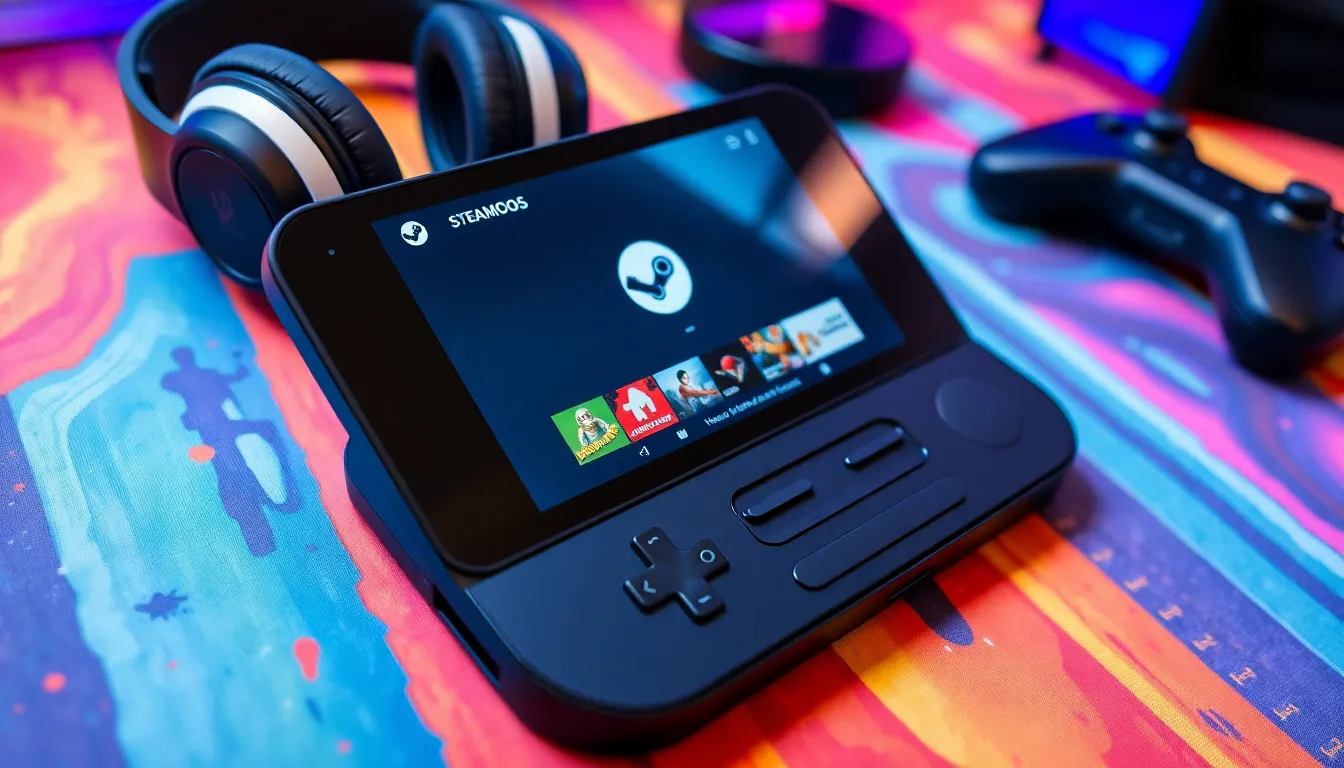Table of Contents
ToggleThe Steam Deck has taken the gaming world by storm, combining the power of a gaming PC with the portability of a handheld device. But what truly sets it apart is its operating system: SteamOS. Imagine a world where your favorite games are just a button press away, and you can play them anywhere—yes, even in bed while pretending to be productive.
Overview of Steam Deck SteamOS
SteamOS serves as the backbone of the Steam Deck, enabling an immersive gaming experience. Built on a Linux base, this operating system optimizes the performance of games across various genres. Users benefit from a user-friendly interface designed for seamless navigation and easy access to gaming libraries.
Integration through Steam allows for cloud saves, ensuring that progress remains intact across multiple devices. Notably, SteamOS supports an expansive selection of titles, including AAA games and indie projects. Graphics performance showcases Vulkan technology, enhancing rendering and reducing resource consumption during gameplay.
Customizability stands out as a key feature, letting players tailor settings according to their preferences. Enhanced support for third-party software permits access to applications beyond the gaming sphere, enriching the device’s functionality. Community support remains strong, offering forums and resources for troubleshooting and modding.
Game compatibility serves as a priority for developers, with Valve continuously striving to improve the library. Frequent updates ensure that SteamOS remains user-centric, addressing both security and performance enhancements. Flexibility allows for installation of alternative operating systems, appealing to tech-savvy users looking for more versatility.
The Steam Deck facilitates offline play, giving users the power to enjoy games without an internet connection. Control options include support for a range of peripherals, enhancing gameplay options for different titles. Ultimately, SteamOS positions the Steam Deck as a formidable entry in the handheld gaming market.
Features of Steam Deck SteamOS

SteamOS boasts various features that enhance the overall gaming experience on the Steam Deck. Its design prioritizes user accessibility and game performance.
User Interface
The user interface is intuitive, allowing for effortless navigation. Menus display game libraries neatly, enabling users to find titles quickly. Customization options offer players the ability to organize their collections to personal preferences. Accessibility features enhance usability for individuals with differing needs. The layout minimizes clutter, promoting seamless interaction with the device. Quick access to settings ensures that gameplay can be adjusted on the fly. Engaging visuals and animations keep the aesthetic appealing while maintaining functionality.
Game Compatibility
Game compatibility remains a core strength of SteamOS. The operating system supports a diverse array of titles, including AAA games and indie projects. Valve continually updates the software, improving performance and expanding the library. Developers prioritize compatibility, ensuring that most games run smoothly on the Steam Deck. Many popular titles feature optimized performance specifically for this handheld device. SteamOS also supports Proton, allowing Windows games to run effectively on the Linux-based system. This extensive compatibility ensures gamers enjoy a wide selection of experiences without major limitations.
Performance Analysis
SteamOS enhances the performance of the Steam Deck, ensuring a remarkable gaming experience. The operating system optimizes speed and responsiveness while maintaining high-quality graphics and sound.
Speed and Responsiveness
Loading times remain minimal thanks to efficient resource management in SteamOS. Quick navigation through the user interface minimizes delays, allowing seamless access to game libraries. Game launches execute smoothly, enabling uninterrupted gameplay. High refresh rates contribute to an overall fluid experience, making fast-paced games enjoyable. Steam Deck’s hardware performance plays a vital role, ensuring compatibility with a wide range of titles without lag. Players appreciate the swift transitions between games and applications, enhancing overall enjoyment.
Graphics and Sound Quality
Graphics capabilities in SteamOS leverage Vulkan technology, delivering stunning visual fidelity. Games display vibrant colors and rich details, which elevate immersive experiences. Optimizations reduce resource consumption while enhancing frame rates, ensuring smooth gameplay across various genres. Sound quality receives equal attention, with immersive audio delivering a captivating atmosphere. The support for surround sound enhances player engagement during gameplay, creating an authentic experience. Valve’s ongoing updates focus on graphical stability, showcasing a commitment to continual improvement. Graphics and sound work in harmony to deliver a gaming environment tailored for enjoyment.
Comparison with Other Operating Systems
SteamOS offers a unique experience compared to traditional systems like Windows and Linux.
Steam Deck SteamOS vs. Windows
SteamOS excels in game compatibility when pitted against Windows. It leverages Proton to run Windows titles efficiently, minimizing performance issues. Customization remains straightforward, fitting a wide range of gaming experiences. Users also benefit from a streamlined interface designed specifically for gaming, which enhances accessibility. Performance optimization in SteamOS often leads to faster game launches and smoother gameplay, unlike Windows, where resource usage can be higher. Valve’s continual updates reinforce stability and compatibility, making SteamOS a solid alternative for gamers seeking minimal hassle.
Steam Deck SteamOS vs. Linux
When comparing SteamOS with traditional Linux distributions, usability stands out prominently. SteamOS simplifies the installation process, especially for those new to Linux. Game library integration proves seamless, as it connects directly with Steam, offering easy access to a vast selection of titles. While many Linux distributions require more technical knowledge, SteamOS features remain user-friendly and intuitive. The support for gaming peripherals enhances the appeal of SteamOS, catering specifically to gamers. Lastly, developers tend to prioritize SteamOS when optimizing games for the Steam Deck, leading to better performance outcomes than on general Linux systems.
Community Feedback and Support
Community feedback plays a vital role in the ongoing development of SteamOS for the Steam Deck. Engaged users often share their experiences through forums and social media platforms, contributing valuable insights that shape future updates. Developers continuously monitor these channels to understand player needs and preferences, ensuring that enhancements align with what the community desires.
Support for users is robust, with numerous online resources available. Official forums and community-generated guides facilitate troubleshooting, making it easier for users to navigate issues. Players also benefit from lively discussions about game performance, optimizations, and modding, enriching the overall gaming experience.
Together, these interactions foster a vibrant ecosystem. Gamers frequently express appreciation for Valve’s responsiveness when addressing bugs and performance hiccups. Regular updates from Valve reflect a commitment to user satisfaction by implementing suggestions that arise from community feedback.
Common inquiries often focus on game compatibility and system performance. Many users highlight improvements in running titles with Proton, showcasing how Valve enhances support for Windows games on the Linux-based operating system. Additional discussions emphasize the importance of resource management, contributing to the overall efficiency of SteamOS on the device.
User customization remains a hot topic. Players appreciate the ability to tailor settings according to their preferences, enhancing personal gameplay experiences. Questions about third-party software support continue to emerge, reflecting the continuous desire to expand functionality.
Community-driven initiatives and user discussions enrich the Steam Deck’s landscape. Gamers actively contribute ideas for new features, which helps Valve prioritize enhancements in future updates. By maintaining open lines of communication, the community and developers can work together, ensuring SteamOS remains a top-notch platform for all players.
The Steam Deck and SteamOS together create a powerful gaming experience that appeals to both casual and hardcore gamers. With its optimized performance and user-friendly interface it redefines handheld gaming. The continuous updates and community involvement ensure that the platform evolves alongside player needs.
SteamOS’s integration with Steam and support for a wide range of titles enhance its appeal while the customizability options allow players to tailor their experience. This combination of features positions the Steam Deck as a leading choice in the gaming market. As Valve continues to prioritize user feedback and performance improvements the future looks bright for SteamOS and its dedicated user base.







